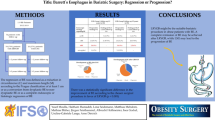Abstract
Introduction
Barrett’s esophagus (BE) is recognized as a premalignant lesion for esophageal adenocarcinoma. BE appears as a consequence of gastroesophageal reflux disease (GERD), which is increased among obese population. Laparoscopic Roux-en-Y gastric bypass (LRYGB) is the best treatment option for obesity combined with GERD. However, data on evolution of BE after LRYGB are scarce.
Methods and procedures
Patients were studied with esophagogastroduodenoscopy (EGD) and gastric biopsy preoperatively. If BE was suspected, esophageal biopsy was performed. If BE was confirmed, LRYGB was indicated with yearly surveillance EGD with biopsies. LRYGB patients who had BE with at least 1-year follow-up were included.
Results
Between 10/07 and 1/16, 2144 patients underwent laparoscopic bariatric surgery at our institution. There were 1681 (78 %) LRYGB, 399 (19 %) laparoscopic sleeve gastrectomies, and 64 (3 %) revisions. Nineteen patients (0.9 %) had BE preoperatively, and they all underwent LRYGB; 11 of them (58 %) were eligible for this study. There were 6 women and 5 men, mean age 49 ± 11 years, initial BMI 44 ± 6 kg/m2. Mean follow-up was 41 ± 31 months; there were 9 short-segment BE (SSBE) and 2 long-segment BE (LSBE). On pre- and post-op EGD, BE length was 2.1 ± 1.6 and 1.2 ± 1.2 cm, respectively (p = NS). Post-op EGD was compatible with BE in all cases, although esophageal biopsy showed remission in 4 (36 %) cases: three short-segment BE (SSBE) and one long-segment BE (LSBE). One patient was indefinite for dysplasia and remained the same after the operation.
Conclusion
Our preliminary data showed that LRYGB is a suitable treatment option for obese patients with BE, demonstrated by 36 % regression rate of this premalignant disease. Although BE persisted in the remaining patients, no progression to dysplasia was observed. A larger number of patients and longer follow-up are needed for more definitive conclusions.

Similar content being viewed by others
References
Braghetto I, Korn O, Csendes A, Gutiérrez L, Valladares H, Chacon M (2012) Laparoscopic treatment of obese patients with gastroesophageal reflux disease and barrett’s esophagus: a prospective study. Obes Surg 22(5):764–772
Akiyamaa T, Yonedab M, Maedab S, Nakajimab A, Koyamaa S, Inamor M (2011) Visceral obesity and the risk of Barrett’s Esophagus. Digestion 83:142–145
Edelstein ZR, Farrow DC, Bronner MP, Rosen SN, Vaughan TL (2007) Central adiposity and risk of Barrett’s esophagus. Gastroenterology 133(2):403–411
Oelschlager BK, Barreca M, Chang L, Oleynikov D, Pellegrini CA (2003) Clinical and pathologic response of Barrett’s esophagus to laparoscopic antireflux surgery. Ann Surg 238(4):458–464 (discussion 464–466)
Madalosso CA, Gurski RR, Callegari-Jacques SM, Navarini D, Thiesen V, Fornari F (2010) The impact of gastric bypass on gastroesophageal reflux disease in patients with morbid obesity: a prospective study based on the montreal consensus. Ann Surg 251:244–248
Nelson LG, Gonzalez R, Haines K, Gallagher SF, Murr MM (2005) Amelioration of gastroesophageal reflux symptoms following Roux-en-Y gastric bypass for clinically significant obesity. Am Surg 71:950–953 (discussion 953–954)
Gastrointestinal Surgery for Obesity (1992) National Institutes of Health Consensus Development Conference Statement. Am J Clin Nutr 55:615S–619S
Lundell LR, Dent J, Bennett JR, Blum AL, Amstrong D, Galmiche JP, Johnson F, Hongo M, Richter JE, Spechler SJ, Tytgat GNJ, Wallin L (1999) Endoscopic assessment of oesophagitis: clinical and functional correlates and further validation of Los Angeles classification. Gut 45(2):172–180
Houghton SG, Romero Y, Sarr MG (2008) Effect of Roux-en-Y gastric bypass in obese patients with Barrett’s esophagus: attempts to eliminate duodenogastric reflux. Surg Obes Relat Dis 4:1–5
Cobey F, Oelschlager B (2005) Complete regression of Barrett’s esophagus after Roux-en-Y gastric bypass. Obes Surg 15(5):710–712
Gurski R, Peters JH, Hagen JA, DeMeester SR, Bremner CD, Chandrasoma PT, DeMeester TR (2003) Barrett’s esophagus can and does regress after antireflux surgery: a study of prevalence and predictive features. J Am Coll Surg 196(5):706–712 (discussion 712–713)
Morrow E, Bushyhead D, Wassenaar E, Hinojosa E, Loviscek M, Pellegrini C, Oelschlager B (2014) The impact of laparoscopic anti-reflux surgery in patients with Barrett’s esophagus. Surg Endosc 28:3279–3284
Perez AR, Moncure AC, Rattner DW (2001) Obesity adversely affects the outcome of antireflux operations. Surg Endosc 15(9):986–989
Mejía-Rivas MA, Herrera-López A, Hernández-Calleros J, Herrera MF, Valdovinos MA (2008) Gastroesophageal reflux disease in morbid obesity: the effect of Roux-en-Y gastric bypass. Obes Surg 18:1217–1224
Grigaites A, Buxhoeveden RB, Helman B, Gorodner V, Carrillo F, Marcolini A, Awruch D (2014) Postoperative morbidity and mortality in laparoscopic bariatric surgery: experience in 1020 patients. Rev Argent Cirug 106(2):103–109
Rossidis G, Browning R, Hochwald S, Abbas H, Kim T, Ben-David K (2014) Minimally invasive esophagectomy is safe in patients with previous gastric bypass. Surg Obes Relat Dis 10(1):95–100
Kuruba R, Jawad M, Karl RC, Murr MM (2009) Technique of resection of esophageal adenocarcinoma after Roux-en-Y gastric bypass and literature review of esophagogastric tumors after bariatric procedures. Surg Obes Relat Dis 5(5):576–581
Nguyen NT, Tran CL, Gelfand DV, Varela E, Chang K, Stamis M, Wilson SE (2006) Laparoscopic and thoracoscopic Ivor Lewis esophagectomy after Roux-en-Y gastric bypass. Ann Thorac Surg 82(5):1910–1913
Author information
Authors and Affiliations
Corresponding author
Ethics declarations
Disclosures
Verónica Gorodner, MD, Rudolf Buxhoeveden, MD, Gastón Clemente, MD, Christian Sánchez, MD, Luis Caro, MD, and Alejandro Grigaites, MD have no conflicts of interest or financial ties to disclose.
Rights and permissions
About this article
Cite this article
Gorodner, V., Buxhoeveden, R., Clemente, G. et al. Barrett’s esophagus after Roux-en-Y gastric bypass: does regression occur?. Surg Endosc 31, 1849–1854 (2017). https://doi.org/10.1007/s00464-016-5184-3
Received:
Accepted:
Published:
Issue Date:
DOI: https://doi.org/10.1007/s00464-016-5184-3




